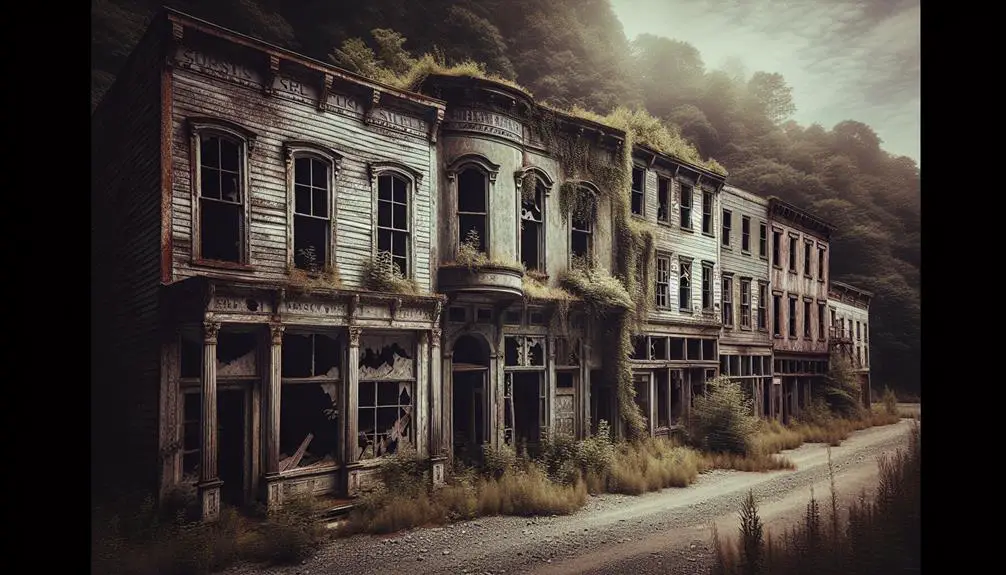Explore the eerie relics of history in abandoned riverside towns across the US. Witness the aftermath of economic struggles, natural disasters, and societal shifts. Uncover dilapidated mansions, ancient storefronts, and silent churches offering a window into the past. Visit famous sites like Cairo, Illinois; Bannack, Montana; and Rodney, Mississippi, echoing tales of prosperity and decline. Discover ongoing efforts to revive these ghostly remnants, preserving heritage trails and historical buildings. Unravel the mysteries of these forgotten towns and the stories they hold.
Key Points
- Riverside ghost towns in the US reflect economic decline and environmental disasters.
- Abandonment linked to ore depletion, struggling logging, agriculture, and natural disasters.
- Architectural remains offer insights into the past of abandoned riverside towns.
- Famous US examples include Cairo, Bannack, and Rodney, preserving tales of prosperous days.
- Preservation efforts aim to revitalize communities, restore cultural heritage, and engage local residents.
History of Riverside Ghost Towns
Explore the fascinating history behind the abandoned Riverside ghost towns in the United States. These towns were once thriving centers of activity, but due to a combination of economic decline and environmental disasters, they now stand as eerie reminders of the past.
The economic decline in these Riverside towns often stemmed from industries that were once their lifeblood facing downturns or moving elsewhere. For example, mining towns saw their fortunes dwindle as ore reserves ran dry or as cheaper sources were discovered elsewhere. Similarly, towns built around logging or agriculture struggled as markets shifted or natural disasters like droughts or floods struck.
Environmental disasters also played a significant role in the abandonment of these Riverside towns. Events like floods, wildfires, or pollution crises could devastate communities, leading residents to seek safer and more stable environments elsewhere. The combined pressures of economic decline and environmental challenges ultimately led to the demise of these once-thriving Riverside settlements.
Causes of Town Abandonment
The causes of town abandonment can be attributed to a complex interplay of economic hardships, environmental catastrophes, and shifting societal dynamics. Environmental disasters, such as floods or droughts, have historically played a significant role in the abandonment of riverside towns. The unpredictability of natural events can devastate communities, leading to the loss of livelihoods and infrastructure, ultimately forcing residents to relocate.
Moreover, economic decline is another key factor in town abandonment. Industries that once thrived in these towns may face downturns, causing businesses to close and unemployment rates to rise. Without economic opportunities, residents find it challenging to sustain their lives in these areas, prompting them to seek better prospects elsewhere.
In addition to these factors, shifting societal dynamics, such as changes in transportation routes or population movements, can also contribute to town abandonment. As people's needs and preferences evolve, some towns may no longer serve a purpose, leading to their eventual abandonment.
Unique Features of River Ghost Towns
Amidst the remnants of history lie the unique features that define river ghost towns in the United States. These towns often boast fascinating architectural remains that offer a glimpse into the past. From dilapidated wooden structures to grandiose abandoned mansions, each building tells a story of the town's former glory. The architectural remains serve as a time capsule, preserving the design and construction techniques of a bygone era.
Furthermore, river ghost towns hold immense cultural significance. These towns were once bustling hubs of activity, home to diverse communities with their own traditions and ways of life. Exploring the cultural remnants of these towns can reveal a wealth of information about the people who once called these places home. From old storefronts that hint at the local economy to abandoned churches that speak of the town's spiritual life, each cultural artifact adds another layer to the town's narrative. By delving into the architectural remains and cultural significance of river ghost towns, one can gain a deeper understanding of the rich history that shaped these now-deserted places.
Famous US River Ghost Towns
With a rich history steeped in tales of bygone eras, several famous US river ghost towns stand as poignant reminders of a vibrant past now lost to time. One such town is Cairo, Illinois, located at the confluence of the Mississippi and Ohio Rivers. Once a bustling hub during the 19th century, Cairo now lays abandoned, with haunting stories of its prosperous days echoing through the empty streets.
Moving westward, you encounter Bannack, Montana, a town established during the Gold Rush. Situated along the banks of the Grasshopper Creek, Bannack boasts a rich history filled with tales of lawlessness and prosperity, now reduced to forgotten relics scattered amongst the decaying buildings.
Further along, the ghost town of Rodney, Mississippi, on the banks of the Mississippi River, tells a story of a once-thriving community that fell into decline after being bypassed by the railroad. As you explore these famous US river ghost towns, you can't help but feel the weight of history and the echoes of lives long gone.
Preservation Efforts for Riverside Ghost Towns
Exploring the abandoned riverside towns in the United States reveals an urgent need for focused preservation efforts to safeguard these historical sites for future generations. Community revitalization initiatives play an essential role in preserving these ghost towns, ensuring their cultural heritage restoration. By engaging local residents and historical preservation groups, these towns can be brought back to life, offering insights into the past while creating opportunities for economic growth.
Preservation efforts often involve restoring key buildings, such as old saloons or general stores, to their former glory. These structures serve as focal points for historical interpretation, drawing visitors and locals alike to learn about the town's history. Additionally, establishing heritage trails or interpretive centers can further enhance the understanding of these riverside ghost towns, fostering a sense of connection to the past.
Through collaborative partnerships between government agencies, non-profit organizations, and passionate individuals, the preservation of these riverside ghost towns can contribute to the revitalization of communities and the protection of America's rich historical tapestry.
Frequently Asked Questions
How Are Abandoned Riverside Towns Different From Other Types of Ghost Towns in the United States?
When considering abandoned towns, riverside locations stand out due to the unique blend of economic impact, tourism potential, historical significance, and urban exploration opportunities they offer. Their proximity to waterways adds a distinct allure.
What Impact Do Abandoned Riverside Towns Have on the Surrounding Environment and Wildlife?
When abandoned, riverside towns can disrupt the environment by contaminating water sources and disrupting ecosystems. Wildlife preservation efforts are challenged as these areas face pollution and habitat destruction, necessitating restoration and conservation initiatives.
Are There Any Legends or Folklore Associated With Specific Abandoned Riverside Towns?
You may find yourself intrigued by haunting stories and local legends that swirl around abandoned towns. Explore mysterious disappearances and ghostly encounters, where the past whispers secrets and the present echoes with eerie tales.
How Do Abandoned Riverside Towns Contribute to the History and Culture of the United States?
Exploring the historical significance of abandoned riverside towns reveals a rich tapestry of American culture. Architectural preservation efforts showcase the enduring legacy of these communities, offering a glimpse into the past that contributes to the nation's collective heritage.
What Challenges Do Preservation Efforts Face in Maintaining Abandoned Riverside Towns?
Maintaining abandoned riverside towns poses challenges. Funding shortages hinder preservation efforts. Community support plays an essential role. Overcoming these obstacles requires strategic planning, innovative solutions, and a shared commitment to safeguarding historical sites for future generations.



